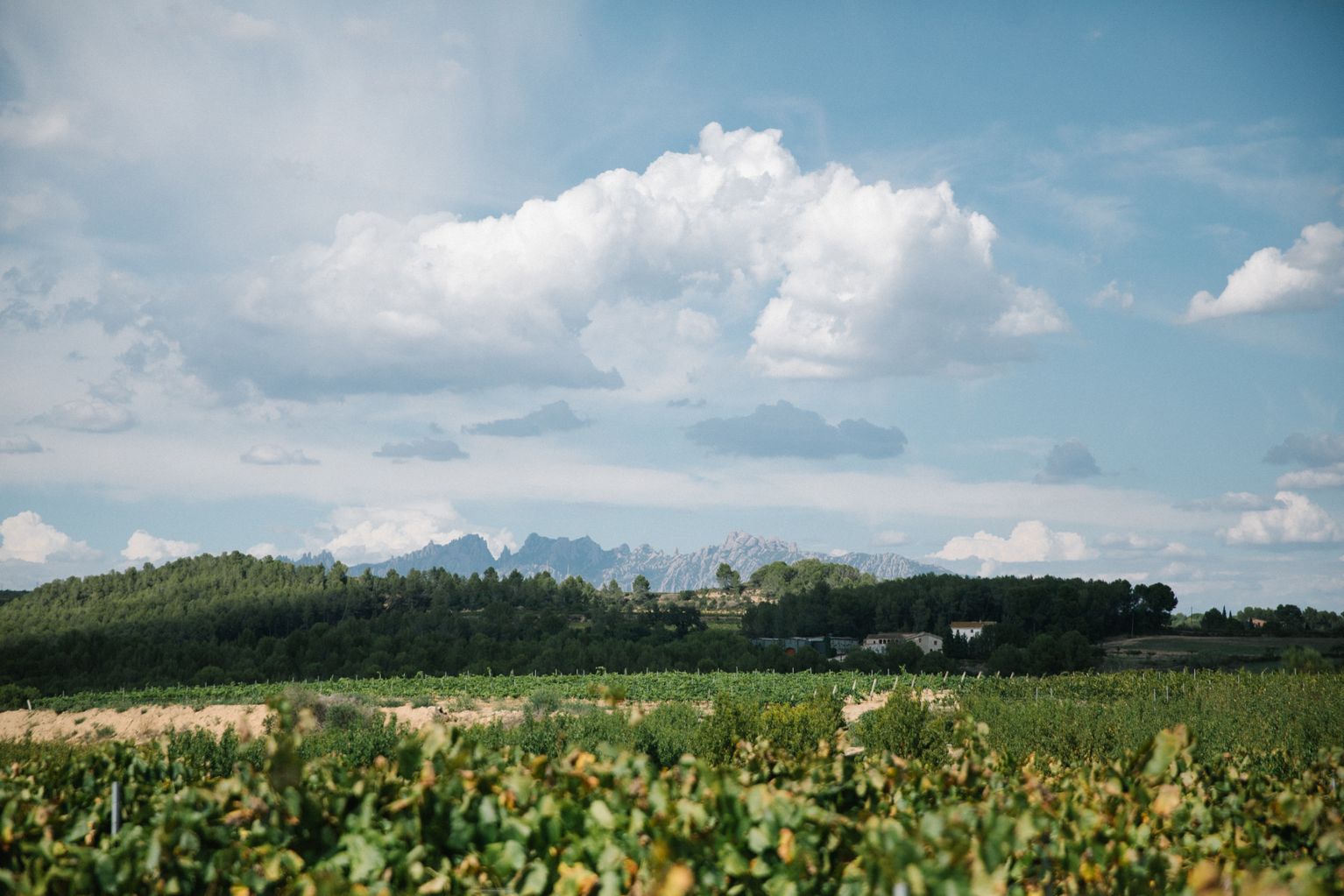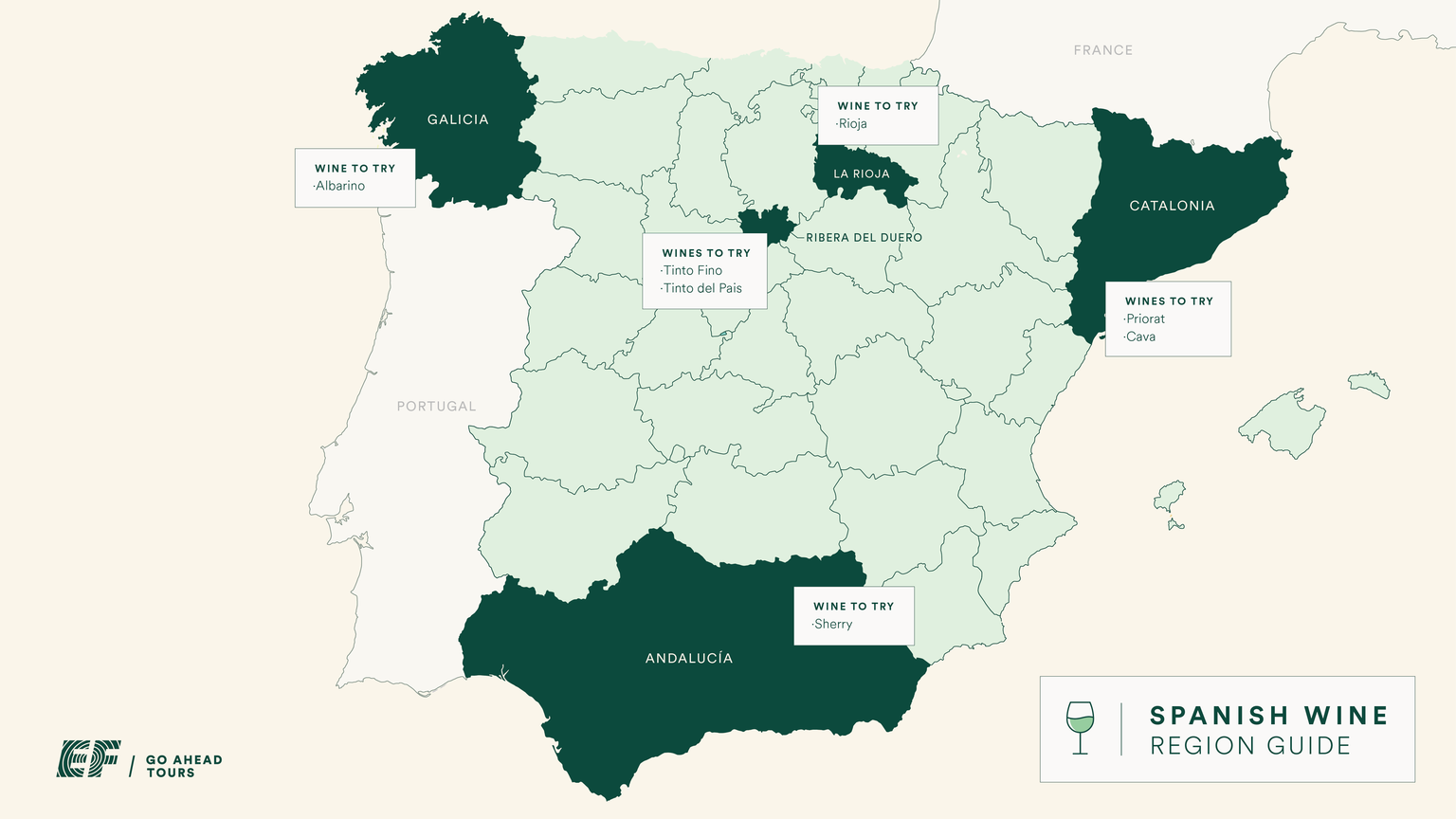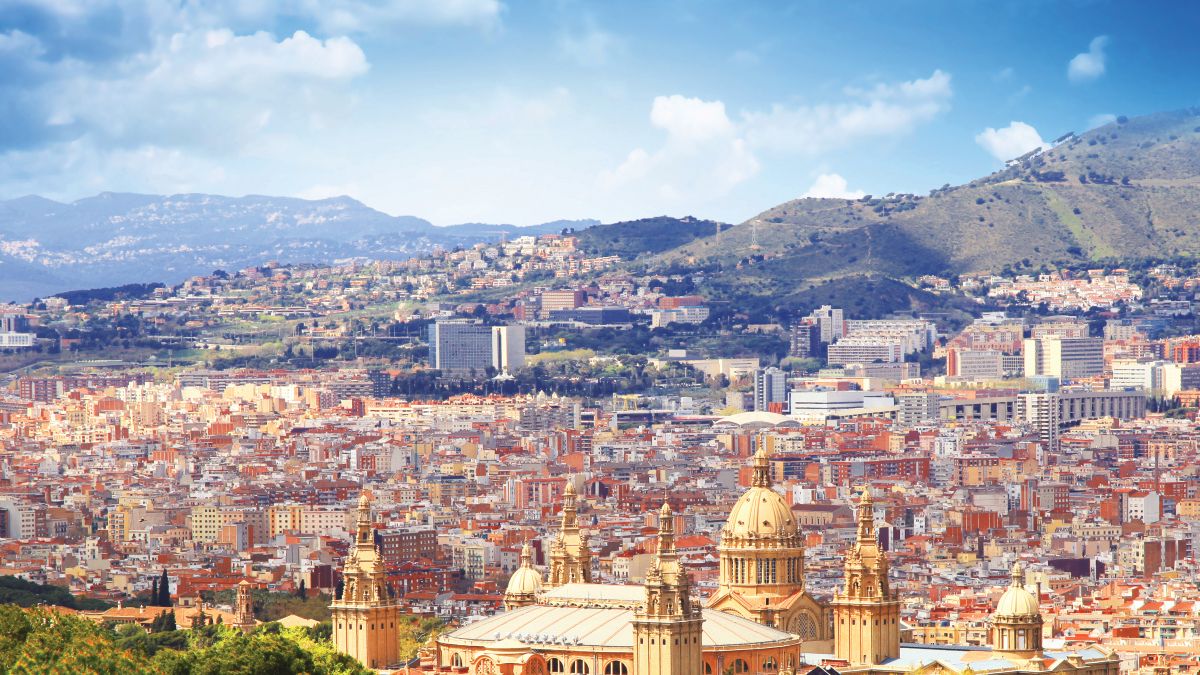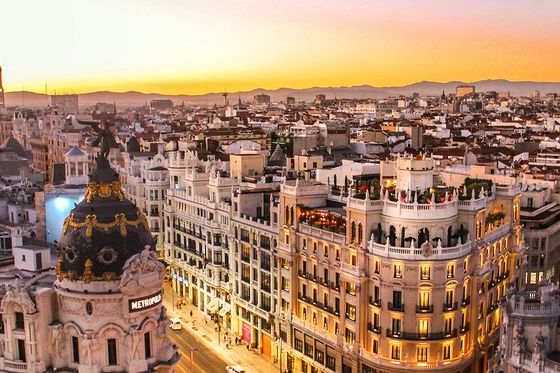
Which Spanish wine regions are the best to visit?
Spain is home to some of the world’s most celebrated wines and most scenic vineyards. From Cava cellars near Barcelona to bold reds in Rioja, discover which Spanish wine regions belong on your list.
Spain’s wine culture is woven into its landscapes, cuisine, and way of life, from sun-warmed plazas to cozy tapas bars. With more vineyard acreage than any other country in the world, Spain’s geography offers a dazzling variety of wines that reflect its diverse regions. From the sunny valleys of Rioja to the seaside hills of Galicia, each of these Spanish wine regions tells a story through its flavors, traditions, and people. When you join us on a tour of Spain, you’ll discover that exploring Spain’s wine regions means more than just tasting the vino—it’s about savoring the culture, history, and rhythm of Spanish life, one glass at a time.
How many Spanish wine regions are there?
Travelers who dream of exploring wine country in Spain will find that nearly every stop on our Spain tours overlaps with a wine region. The country is the world’s third-largest wine producer (Italy holds the number one spot) and has the largest area of land dedicated to vineyards of any nation in the world. In fact, there are more than 70 official Spanish wine regions (compared to France’s 17 and Italy’s 20), making this Iberian destination a true paradise for wine lovers. Whether you’re raising a glass of crisp albarino by the sea or sipping a bold tempranillo inland, you are never far from a local glass of wine when you join us on a tour of Spain.

Rioja: the crown jewel of Spanish wine regions
Located in the north, near Bilbao, lies Rioja, a Spanish region with a namesake wine. Protected by mountain ranges and blessed with plenty of sun, the Rioja wine region produces Spain’s most famous red wines. Of all the Spain regions, few capture the romance of wine country like Rioja. Here, you’ll find rolling vineyards, cozy tapas bars serving hyper-local fare, and even a museum dedicated to wine culture. It’s a place where the landscape and way of life are inseparable from the wine itself. “Don’t miss [the] museum of wine and underground bodegas,” said traveler Bonum after visiting on our Food & Wine: A Taste of Spain tour. “[It was] really, really worthwhile. Actually, [I] could have stayed longer in the museum.”
The wine to try in the Rioja wine region: Rioja
Rioja wines are known for their balance of fruit, oak, and spice, and for the way they evolve beautifully with age. Seven different types of grapes are permitted in the making of Rioja wines, including graciano and mazuelo, but the most common (and our favorite!) is tempranillo. It accounts for about 75% of the grapes grown in the Rioja region and is the fourth-most popular grape in the world. Young tempranillos are fresh and fruity, while barrel-aging brings out bold, earthy flavors like leather and tobacco. That versatility makes it easy to find a Rioja wine for any occasion. It’s no wonder we highlighted Rioja as one of the best wines in Spain in our Food and Wine Guide to Spain.
Pairs well with: While aged Riojas are a great pairing for big, hearty meals, younger Riojas pair well with lighter dishes, like pastas, vegetables, and rice. The moral of the story: You can’t go wrong with a glass of Rioja at dinner (or lunch!) on our Spain tours.
The best place to try this wine on tour: Bilbao and the Rioja countryside
Wander through Logrono, the capital of the Rioja region, on our Food & Wine: A Taste of Spain tour or our Food & Wine: Barcelona & Northern Spain with America’s Test Kitchen tour. Here in Spanish wine country, tapas bars line cobblestone streets and wine flows freely. Or arrive in Bilbao on our Northern Spain: Basque Country to Madrid tour, just a stone’s throw from La Rioja. Clinking glasses with your fellow travelers is a fantastic way to kick off a tour of Spain.

Ribera del Duero: where bold wines meet timeless Spain
Stretching along the banks of the Duero River, Ribera del Duero is another stunning wine region of Spain. With hot days, cold nights, and soils rich in limestone and clay, this Spanish wine region produces powerful, deeply colored reds. This high-altitude plateau is dotted with medieval castles and quiet villages, giving Ribera del Duero a sense of old-world Spain that’s as enduring as its wines.
The wine to try in Ribera del Duero: tinto fino or tinto del pais
These grapes are unique to this region and produce decadent, full-bodied reds. The area’s mountains protect the plateau and create extreme weather shifts, from hot and very dry summers to below-freezing temperatures and harsh winters. The big shifts in climate between day and night help create grapes with complex flavors for the local wines. Regulations for the region mandate that wines must have at least 75% tempranillo grapes, and the remaining balance is usually made up of cabernet, merlot, and malbec grapes. Tinto wines are aged in barrels for between one and three years before they are bottled. They are known for their flavors of plum, blackberry, and cassis, with notes of spice, leather, and tobacco from their time in barrels.
Pairs well with: Aged cheeses and hearty dishes like stews, beef goulash, sausage, steak, venison, and lamb chops.
The best place to try this wine on tour: Madrid or Salamanca
You’ll find Ribera del Duero wines all over Spain, but the region is fairly close to the capital, so enjoy it locally on any of our Madrid tours. Join our Food & Wine: A Taste of Spain tour to go straight to the source and spend a night in the Ribera del Duero countryside, complete with a vineyard dinner and wine tasting. Other cities close to the region, like Salamanca and Segovia, are favorite stops on our Northern Spain: Basque Country to Madrid tour. Join our optional Salamanca Countryside Food & Wine Tasting Tour excursion, which features local wines from the Ribera del Duero Spanish wine region.
)
Priorat: where hardened landscapes yield refined wines
Tucked into Catalonia’s rugged hills, Priorat is one of only two DOCa-classified wine regions in Spain (alongside Rioja). This hard-to-come-by label translates to “Qualified Designation of Origin” in English and denotes Spanish wine regions that have a meticulous record of prestige. Old-vine garnacha and carignan grapes cling to terraced, slate-streaked slopes, producing intense, small-batch wines cherished by collectors. The dramatic slate soil gives the vineyards a stark, almost lunar beauty, while medieval villages dot the landscape, adding a timelessness to the region. Despite its secluded feel, Priorat lies just a few hours from Barcelona, one of Spain’s most cosmopolitan cities.
The wine to try in Priorat: Priorat red blends
Bold and mineral-driven, Priorat’s reds are made from a backbone of garnacha and carignan, sometimes softened with touches of merlot or cabernet sauvignon. The steep, mountainous terrain is exposed to the elements, which naturally limits yields. As a result, production is small, which makes these wines rare and highly sought after. Expect deep colored wine with layers of dark fruit, herbal notes, and a slate-like minerality that speaks to the region’s rocky soils.
Pairs well with: Grilled meats, rich pastas, and dishes that match the wine’s intensity.
The best place to visit to try this wine on tour: Barcelona
While Priorat itself feels worlds away, Barcelona is your gateway to tasting these iconic wines. Many of the city’s acclaimed wine bars and restaurants highlight Priorat on their lists, giving you the chance to sip its bold reds without leaving the city. On our Food & Wine: A Taste of Spain tour or our A Week in Spain: Barcelona, Madrid & Seville tour, your time in Barcelona puts you in perfect reach of these celebrated bottles.
)
Penedes: the sparkling Spanish wine region near Barcelona
Champagne might be one of the best-known wine regions in France, but Spain has Penedes. Just outside Barcelona lies this effervescent soul of Spanish wine country. Here, underground cellars hold millions of bottles of Cava, Spain’s signature sparkling wine. One of the wine regions of Spain that’s easiest to access from a major city, Penedes is a landscape of rolling vineyards framed by the Mediterranean on one side and the jagged Montserrat mountains on the other. It’s a place where centuries-old winemaking traditions live alongside the avant-garde art, dreamy architecture, and culinary culture that Barcelona is famous for.
The wine to try in Penedes: Cava
Made using the same methode traditionnelle as Champagne, Cava is crisp, lively, and full of fine bubbles. Macabeo grapes bring floral notes, xarel·lo adds body and structure, and parellada lends brightness—together creating a sparkling wine that’s refreshing, versatile, and distinctly Spanish. In fact, Cava is protected under the Designation of Origin, meaning that in order to be categorized as a Cava, the wine must be both produced in the method described above and within specific regions of Spain.
Pairs well with: Tapas, seafood, or anything worth celebrating—like, say, the beginning or ending of an unforgettable tour of Spain!
The best place to try this wine on tour: Barcelona
Join our Food & Wine: A Taste of Spain tour or our Food & Wine: Barcelona & Northern Spain with America’s Test Kitchen tour, and after a morning exploring the vibrant city of Barcelona, we’ll whisk you just outside the city’s limits to tour the underground cellars of a local winery and taste Cava at its birthplace. Cava is one of the best things to drink in and around Barcelona, according to our Barcelona Travel Guide, and it’s enjoyed any time of day, so feel free to indulge!

Rias Baixas: Spain’s wine country by the coast
Galicia is one of the most interesting regions of Spain and can feel worlds away from the rest of the country. This lush, windswept area in northwest Spain feels almost Celtic compared to the sun-soaked south or the golden hills of central Spain, and it’s home to a Spanish wine region formed by a network of inlets and estuaries along the coast, Rias Baixas. The area is a patchwork of verdant hills, salt-flecked coves, and quaint fishing towns where life moves with the rhythm of the tides. “Northern Spain is a must-see part of the Iberian Peninsula!” said traveler Carolyn after joining our Northern Spain: Basque Country to Madrid tour.
The wine to try in Rias Baixas: albarino
Rias Baixas’ crisp, citrusy white wine is fresh, aromatic, and perfect for coastal dining. Albarino grapes love the region’s misty, temperate climate, which preserves their citrusy, floral flavors and helps develop a lively freshness and delicate minerality that mirrors the sparkling waters of the Rias Baixas themselves.
Pairs well with: Mussels, scallops, and grilled fish.
The best place to try this wine on tour: Rias Baixas
Join the Rias Baixas Cruise & Galician Lunch excursion on our Northern Spain: Basque Country to Madrid tour to cruise along the Rias Baixas while snacking on local mussels and sipping albarino wine on board the boat. Later, wander through the fishing village of Combarro, one of the most beautiful towns in Galicia. One travel tip? July can get very hot in parts of southern Spain, but it’s one of the best times to visit Spain to cruise the cool Rias Baixas.

Jerez: sherry, sunshine, and the magic of southern Spain
Few Spanish regions offer wines as distinctive as the ones produced in Jerez in Andalusia. The region (also known as The Jerez Triangle) refers to the area surrounding the towns of Jerez de la Frontera, Sanlucar de Barrameda, and El Puerto de Santa María. Beyond the vineyards, Jerez is Andalusian through and through. Think palm-lined streets, sunlit plazas, and sultry evenings where locals gather to watch flamenco, a tradition born here. The Moorish and Spanish influences mix in the tiled courtyards, grand cathedrals, and colorful markets that make this region unforgettable.
The wine to try in Jerez: sherry
Jerez offers a different kind of wine experience. Its signature fortified wine, sherry, isn’t just one wine—it’s a whole spectrum of styles, all born in the cellars of the Jerez Spanish wine region and often savored like whiskey or cognac, rather than sipped like wine. From the pale, crisp, and slightly salty sherry called fino, to the richer, nutty, amber-hued amontillado sherry, to the dark, velvety Oloroso sherry with flavors of dried fruit and spice, there’s a sherry for nearly every mood and palate. For those with a sweet tooth, Pedro Ximenez (PX) is like dessert in a glass: syrupy and decadent with a hint of raisin.
What makes sherry unique is the solera system, a continual layered method of blending wines across many vintages. Imagine rows of barrels stacked on top of each other, with the oldest sherry resting at the bottom. Each year, a portion is drawn from the bottom barrels for bottling, then topped up with younger wine from the layers above. This creates an endless supply of consistently aged and blended wine.
Pairs well with: Sip fino with seafood, enjoy amontillado with meat and cheese, and try PX drizzled over ice cream.
The best place to try this wine on tour: Cadiz
Join our Journey through Andalusia: Seville, Granada & Malaga tour to head to the heart of this diverse and sun-soaked Spanish wine region. You’ll explore medieval cities, stroll through charming beach towns, and pair sherry with the bold flavors of Andalusian cuisine. Join the Cadiz & Sherry Tasting excursion from Seville to visit the ancient port city of Cadiz and taste a variety of different sherries in a local tavern. “My friends and I loved our tour,” said traveler Virginia after returning from the tour. “We learned so much and tasted 60 wines and lots of regional Spanish food. Loved the Jerez Iberian ham side excursion and the olive farm. I will be back to Spain. I’m in love!”
)
Planning a Spain wine regions trip
If you’ve learned one thing thus far, it’s that when dreaming up a perfect trip to wine country, Spain is your ticket. The culture and landscapes of Spain’s wine regions are as varied as the wine itself, which means there’s something for every kind of traveler. Here’s how to make the most of your trip to Spain’s wine country.
When to visit
Spring is one of our favorite times to explore Spain’s vineyards. You’ll be met with mild weather, fewer crowds, and the chance to see the countryside in full bloom. However, the harvest season in the fall adds an extra level of excitement, with wine festivals and the flurry of activity surrounding the harvest. Summer is the perfect time to visit the cooler Spain wine regions in the north, while a winter trip calls for bold reds and hearty fare in the still-warm south. (Looking for some tips on exploring the southernmost wine regions of Spain? Check out our guide to the best things to do in southern Spain for ideas.)
What to expect on a wine tour
Whether you’re strolling through medieval villages in Rioja, cruising along Galicia’s estuaries with a glass of albarino, or stepping into the cool underground cellars of Penedes, each of our Spain tours blends culture, history, and plenty of Spanish wine. When you join one of our Food & Wine Tours, expect a mix of tastings, traditional meals, farm visits, and time to enjoy the cities and the scenery. “The food, the wine, the excursions, everything was on point,” said traveler Debi after joining our Food & Wine: A Taste of Spain tour. “We covered everything from the Rioja wines to the Cava, the olive oil tasting to churros and chocolate. Great itinerary!”
Since moving abroad for college at the age of 18, Steph’s never doubted that travel is her passion in life. When she isn’t seeking opportunities to satisfy her wanderlust—and inspiring others to do the same—you’ll find her exploring Boston’s vegan food scene, shopping for eclectic pieces to add to her closet, or rewatching 90s romantic comedies.
































































































